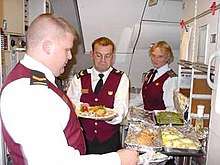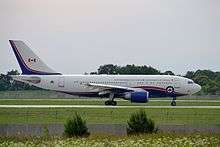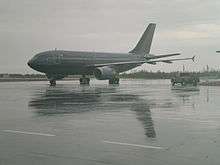Royal Canadian Air Force VIP aircraft
The Royal Canadian Air Force (RCAF) maintains specialised aircraft to transport Canada's monarch, governor general, members of the Royal Family, prime minister, senior members of the Government of Canada, and other dignitaries.[1][2] A small fleet of dedicated executive government transport aircraft are organised into two RCAF squadrons. Other RCAF combat and transport helicopters and fixed-wing aircraft, chartered civilian aircraft, and occasionally scheduled commercial flights may also be used to meet Canada's VIP air transport requirements.
History
Members of the Royal Family have been flying in the United Kingdom since two Westland Wapitis were delivered to the Royal Air Force's No. 24 Squadron at RAF Northolt in April 1928. Between the following year and 1935, Prince Edward, Prince of Wales, himself purchased 13 aircraft; he became the first member of the Royal Family to be a pilot and,[3] when he ascended to the throne in 1936 as King Edward VIII, the King's Flight was formed as the world's first head of state aircraft unit.[4]
.jpg)

Executive air transport in Canada can be traced to the formation of the Royal Canadian Air Force (RCAF) in the 1920s; the only VIP death in the history of the RCAF was Minister of National Defence Norman McLeod Rogers on 10 June 1940, near Newtonville, Ontario. The RCAF maintained aircraft such as the Lockheed Lodestar, Canadair North Star, Canadair CL-66, and Canadair CL-44-6 until, following the 1968 unification of the country's three armed forces branches into the Canadian Forces, long range VIP transport was carried out using a modified Boeing 707 designated as the CC-137 Husky and short range VIP transport used various combat fixed and rotary wing aircraft. Dedicated VIP transport aircraft did not enter the Canadian Forces until the early 1980s, when 12 CL-600S Challenger business jets were purchased by the Governor General-in-Council from Canadair, which were thereafter given the designations CC-144, CE-144, and CX-144, and painted in the contemporary red and white livery of the Canadian Forces. These jets flew with 414 "Black Knight" Squadron at CFB North Bay until July 1992, and with 434 "Blue Nose" Squadron at CFB Greenwood until May 2000, when eight aircraft were either sold or retired, the remaining two being transferred to 412 Transport Squadron for dedicated executive transport, where the livery was changed to a dark Air Force blue.
At times, the use of executive air transport has been a contentious issue. In 2002, the Governor General-in-Council, on the advice of Prime Minister Jean Chrétien, purchased an additional two Challenger jets for exclusive royal, viceroyal, and ministerial transport. Use of these planes by ministers of the Crown came under heavy criticism, partly due to the high cost of operation— approximately CAD$11,000 per hour[5]— as well as questions over prioritisation of other military aircraft procurement. Government ministers have typically explained that the use of the Challenger jets is necessary due to time constraints and/or security issues. Also, Governor General Adrienne Clarkson had used a chartered aircraft to fly from Ottawa to her cottage in Muskoka, Ontario, and it was later revealed that Governor General Michaëlle Jean was flown to The Bahamas on a Canadian Forces Challenger. Both times, the press reports of these actions brought criticism towards the viceroys from some corners; however, the governor general's mode of transport is directed by the Royal Canadian Mounted Police.[6]
Present arrangements


All dedicated VIP transport aircraft in the Canadian Forces are operated by 437 Transport Squadron and 412 Transport Squadron. Attendants on flights operated by these squadrons are select volunteers from various services in the Canadian Forces and serve in their posting for two or three years; they must undergo an intensive training period and additional security background checks prior to VIP transport duty.
The 437 Transport Squadron, based at CFB Trenton,[7] operates five Airbus A310-300s, all designated as CC-150 Polaris; four are configured as normal airliners with cargo transport and aerial refuelling capability, while one, No. 001, is operated in a VIP configuration.[8] This latter aircraft, known officially as Can Force One[9], and referred to as the Royal Flight when carrying the Queen or another member of the Royal Family,[8][10][11] has a galley, spartan bedroom (wall panels added to provide privacy with small bed and sofa),[12] sitting room, office space, and a shower approximately the size of a small phone booth. The executive suite includes a satellite telephone, two computer work stations, and a small refrigerator, and at the rear portion of the aircraft is a normal passenger cabin, used to carry regular military passengers, members of the VIP party, or reporters. The squadron's information officer stated of the interior in 1997: "It's no more luxurious than a good motor home."[8]
412 Transport Squadron, based at Macdonald-Cartier International Airport (formerly CFB Ottawa, and previously at CFB Uplands), is the only RCAF unit dedicated exclusively to executive transport and currently operates Canada's four CC-144-designated Bombardier Challenger 601 business jets in a VIP configuration.
See also
- Royal and viceroyal transport in Canada
- Air transports of heads of state and government
- The Canadian Crown and the Canadian Forces
- Royal tours of Canada
- Royal Australian Air Force VIP aircraft
- Air transport of the Royal Family and government of the United Kingdom
References
- Department of National Defence. "Air Force > Aircraft > CC-150 Polaris". Queen's Printer for Canada. Archived from the original on 5 December 2010. Retrieved 11 December 2009.
- Department of National Defence. "Air Force > Aircraft > CC-144 Challenger". Queen's Printer for Canada. Archived from the original on 5 December 2010. Retrieved 11 December 2009.
- Pigott, Peter (2005). Royal Transport: An Inside Look at the History of Royal Travel. Toronto: Dundurn Press. p. 15. ISBN 978-1-55002-572-9.
- Francillon, René (November 1999). "Fit for a King: Wings for Sovereigns, Presidents and Prime Ministers". Air International. London: Key Publishing Ltd. 57 (5): 289–290.
- Cheadle, Bruce (25 October 2006). "PMO officials not required to publicly post cost of Challenger flights: Tories". CNews. Canoe. Archived from the original on 25 October 2008. Retrieved 12 May 2007.
- Harris, Kathleen (12 July 2006). "Fed jets idle under Tories". CNews. Canoe. Archived from the original on 11 July 2012. Retrieved 12 May 2007.
- Murphey, D.C. (29 November 2002). "437 Squadron's support to Her Majesty's Golden Jubilee visit". Contact. Trenton: CFB Trenton. 37 (46). Retrieved 4 September 2008.
- Keene, Tony (1997). "Canada's Royal Flight: A Visit to 437 Transport Squadron". Monarchy Canada. Toronto: Monarchist League of Canada. Archived from the original on 21 April 2009. Retrieved 11 December 2009.
- http://www.cbc.ca/news/politics/can-force-one-replacement-1.4558838
- MacLeod, Kevin S. (2008), A Crown of Maples (PDF) (1 ed.), Ottawa: Queen's Printer for Canada, p. 60, ISBN 978-0-662-46012-1, retrieved 12 March 2010
- Pigott, Peter (1 January 2005). Royal Transport: An Inside Look at the History of Royal Travel. Toronto: The Dundurn Group. p. 185.
- https://stateceremony.wordpress.com/category/air-transport/